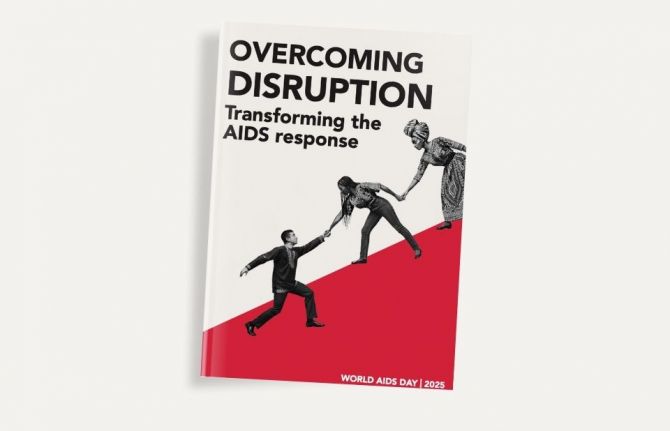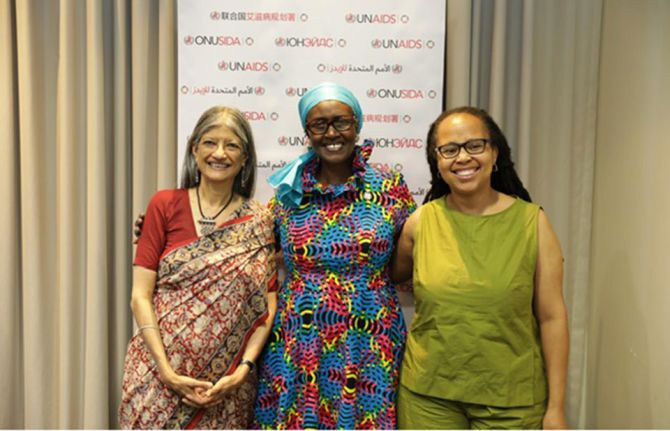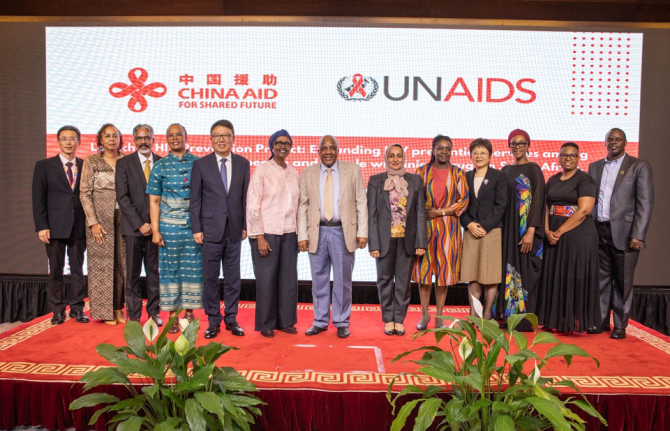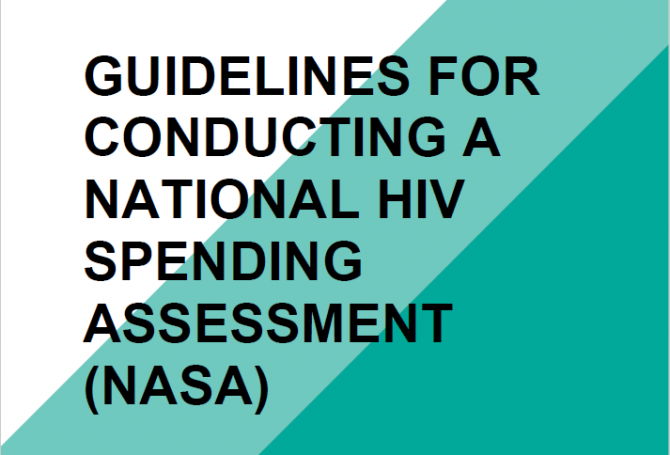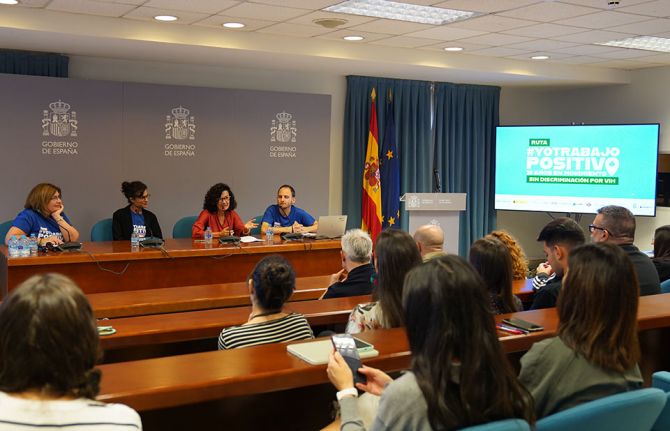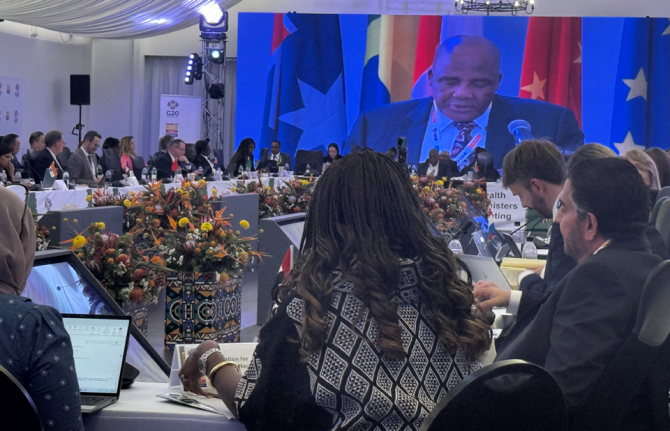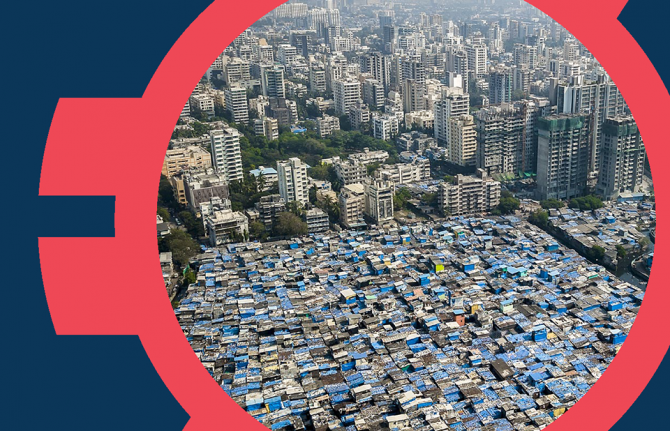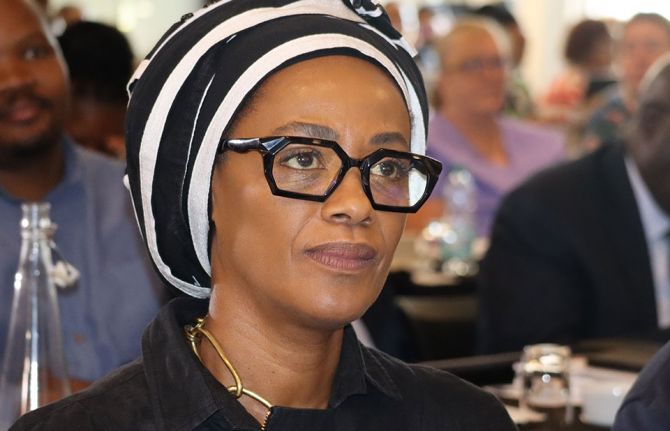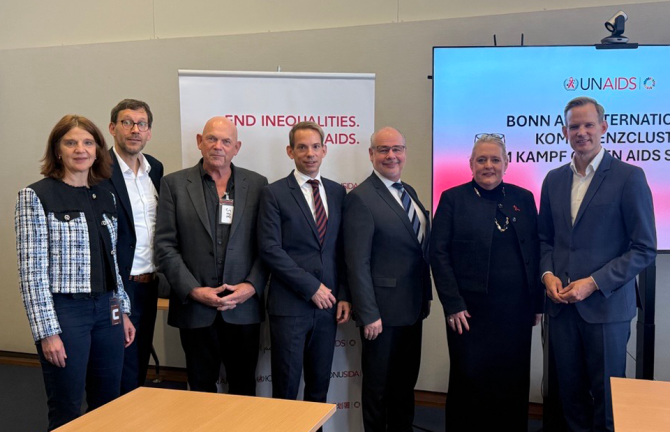
Press Release
UNAIDS and StarTimes join to promote World AIDS Day messages
30 November 2016 30 November 2016StarTimes—the UNAIDS media partner—broadcasts HIV prevention message across African network
GENEVA, 1 December 2016—UNAIDS and media partner StarTimes are working together to reach millions of people with World AIDS Day messages on the theme of HIV prevention. UNAIDS has produced two short videos that promote the life-cycle approach to HIV prevention—finding HIV solutions for everyone, at every stage of life. StarTimes will broadcast the videos across their African networks in English and French from today until the end of the year.
StarTimes is a major digital television operator licensed to broadcast in 30 countries across Africa. No one should be left behind by the AIDS response. Promoting HIV prevention options alongside HIV testing and treatment can ensure that the world will get on the Fast-Track to end the AIDS epidemic as a public health threat by 2030.
The videos can be viewed on UNAIDS YouTube channel at the following links:
UNAIDS
The Joint United Nations Programme on HIV/AIDS (UNAIDS) leads and inspires the world to achieve its shared vision of zero new HIV infections, zero discrimination and zero AIDS-related deaths. UNAIDS unites the efforts of 11 UN organizations—UNHCR, UNICEF, WFP, UNDP, UNFPA, UNODC, UN Women, ILO, UNESCO, WHO and the World Bank—and works closely with global and national partners towards ending the AIDS epidemic by 2030 as part of the Sustainable Development Goals. Learn more at unaids.org and connect with us on Facebook, Twitter, Instagram and YouTube.
StarTimes
StarTimes is the leading digital-TV operator in Africa, serving nearly 10 million subscribers and covering 90% of the continent's population with a massive distribution network of 200 brand halls, 3,000 convenience stores and 5,000 distributors. StarTimes owns a featured content platform, with 440 authorized channels consisting of news, movies, series, sports, entertainment, children's programs, fashion, religion etc. The company's vision is "To enable every African family to afford and enjoy digital TV" StarTimes achieves this by combining satellite and terrestrial DTV systems to provide an open and secure digital wireless platform. The company provides a robust signal transmission service for public and private broadcasters, offers consumers outstanding Pay-TV programs, mobile multimedia, wireless Internet connectivity and convenient online services including checking TV guide; watching free live football; chatting with celebrities and friends.
Contact
UNAIDS GenevaAlasdair Reid
tel. +41 22 791 1352
reida@unaids.org
StarTimes Beijing
Raissa Girondin
tel. +861053012241
raissagi@startimes.com.cn
Press centre
Download the printable version (PDF)



Press Release
UNAIDS announces 18.2 million people on antiretroviral therapy, but warns that 15–24 years of age is a highly dangerous time for young women
21 November 2016 21 November 2016New UNAIDS report shows that people are particularly vulnerable to HIV at certain points in their lives and calls for a life-cycle approach to find solutions for everyone at every stage of life
WINDHOEK/GENEVA, 21 November 2016—A new report by UNAIDS shows that countries are getting on the Fast-Track, with an additional one million people accessing treatment in just six months (January to June 2016). By June 2016, around 18.2 million [16.1 million–19.0 million] people had access to the life-saving medicines, including 910 000 children, double the number five years earlier. If these efforts are sustained and increased, the world will be on track to achieve the target of 30 million people on treatment by 2020.
Get on the Fast-Track: the life-cycle approach to HIV was launched today in Windhoek, Namibia, by the President of Namibia, Hage Geingob and the Executive Director of UNAIDS, Michel Sidibé. “Just under two years ago, 15 million people were accessing antiretroviral treatment—today more than 18 million are on treatment and new HIV infections among children continue to fall,” said President Geingob. “Now, we must ensure that the world stays on the Fast-Track to end the AIDS epidemic by 2030 in Namibia, in Africa and across the world.”
The report contains detailed data on the complexities of HIV and reveals that girls’ transition to womanhood is a very dangerous time, particularly in sub-Saharan Africa. “Young women are facing a triple threat,” said Mr Sidibé. “They are at high risk of HIV infection, have low rates of HIV testing, and have poor adherence to treatment. The world is failing young women and we urgently need to do more.”
HIV prevention is key to ending the AIDS epidemic among young women and the cycle of HIV infection needs to be broken. Recent data from South-Africa shows that young women are acquiring HIV from adult men, while men acquire HIV much later in life after they transition into adulthood and continue the cycle of new infections.
The report also shows that the life-extending impact of treatment is working. In 2015, there were more people over the age of 50 living with HIV than ever before—5.8 million. The report highlights that if treatment targets are reached, that number is expected to soar to 8.5 million by 2020. Older people living with HIV, however, have up to five times the risk of chronic disease and a comprehensive strategy is needed to respond to increasing long-term health-care costs.
The report also warns of the risk of drug resistance and the need to reduce the costs of second- and third-line treatments. It also highlights the need for more synergies with tuberculosis (TB), human papillomavirus (HPV) and cervical cancer, and hepatitis C programmes in order to reduce the major causes of illness and death among people living with HIV. In 2015, 400 000 of the 1.1 million people who died from an AIDS-related illness died from TB, including 40 000 children.
“The progress we have made is remarkable, particularly around treatment, but it is also incredibly fragile,” said Mr Sidibé. “New threats are emerging and if we do not act now we risk resurgence and resistance. We have seen this with TB. We must not make the same mistakes again.”
Get on the Fast-Track: the life-cycle approach to HIV outlines that large numbers of people at higher-risk of HIV infection and people living in high-burden areas are being left without access to HIV services at critical points in their lives, opening the door to new HIV infections and increasing the risk of dying from AIDS-related illnesses. The report examines the gaps and approaches needed in HIV programming across the life cycle and offers tailored HIV prevention and treatment solutions for every stage of life.
"Ending AIDS is possible only if we join hands—by each doing what is within our scope, creatively and aggressively embracing the 90–90–90 targets," said Eunice Makena Henguva, Youth Economic Empowerment Project Officer for the Namibian Women's Health Network.
From birth
Globally, access to HIV medicines to prevent mother-to-child transmission of HIV has increased to 77% in 2015 (up from 50% in 2010). As a result, new HIV infections among children have declined by 51% since 2010.
The report highlights that of the 150 000 children who were newly infected with HIV in 2015, around half were infected through breastfeeding. It stresses that infection through breastfeeding can be avoided if mothers living with HIV are supported to continue taking antiretroviral medicines, allowing them to breastfeed safely and ensure that their children receive the important protective benefits of breastmilk.
Testing also remains a major issue. The report shows that only four of 21 priority countries in Africa provided HIV testing for more than half the babies exposed to HIV within their first weeks of life. It also shows that in Nigeria, which accounts for more than a quarter of all new HIV infections among children globally, only half of pregnant women living with HIV are tested for HIV.
Get on the Fast-Track: the life-cycle approach to HIV stresses that more efforts are needed to expand HIV testing for pregnant women, expand treatment for children and improve and expand early infant diagnosis by using new diagnostic tools and innovative methods, such as SMS reminders, to retain mothers living with HIV and their babies in care.
The report also encourages countries to adopt the targets of the Start Free, Stay Free, AIDS Free framework led by UNAIDS and the United States President’s Emergency Plan for AIDS Relief to reduce the number of new HIV infections among children, adolescents and young women, and ensure lifelong access to antiretroviral therapy if they are living with HIV.
Through adolescence
The report shows that the ages between 15 and 24 years are an incredibly dangerous time for young women. In 2015, around 7500 young women became newly infected with HIV every week. Data from studies in six locations within eastern and southern Africa reveal that in southern Africa girls aged between 15 and 19 years accounted for 90% of all new HIV infections among 10–19-year-olds, and more than 74% in eastern Africa.
Globally, between 2010 and 2015, the number of new HIV infections among young women aged between 15 and 24 years was reduced by just 6%, from 420 000 to 390 000. To reach the target of less than 100 000 new HIV infections among adolescent girls and young women by 2020 will require a 74% reduction in the four years between 2016 and 2020.
Many children who were born with HIV and survived are now entering adulthood. Studies from 25 countries in 2015 show that 40% of young people aged between 15 and 19 years became infected through mother-to-child transmission of HIV. This transition is also magnifying another major challenge—high numbers of AIDS-related deaths among adolescents. Adolescents living with HIV have the highest rates of poor medication adherence and treatment failure.
A range of solutions are needed to respond to the specific needs of adolescents, including increased HIV prevention efforts, keeping girls and boys in school, increasing HIV testing and voluntary medical male circumcision, pre-exposure prophylaxis and immediate access to antiretroviral therapy.
Key populations
In 2014, an estimated 45% of all new HIV infections globally were among members of key populations and their sexual partners. The report warns that new HIV infections are continuing to rise among people who inject drugs (by 36% from 2010 to 2015) and among gay men and other men who have sex with men (by 12% from 2010 to 2015) and are not declining among sex workers or transgender people.
The report outlines the critical need to reach key populations with HIV prevention and treatment programmes that meet their specific needs throughout their lives; however, total funding levels are far below what is needed for HIV programmes to reach key populations, particularly funding from domestic sources.
Adulthood
In July 2016, in the HIV prevention gap report, UNAIDS warned that HIV prevention efforts are not working for adults and that new HIV infections among adults have failed to decline for at least five years. Get on the Fast-Track: the life-cycle approach to HIV cites concerns that western and central Africa is off-track in responding to HIV. The region accounts for 18% of people living with HIV, but a serious lack of access to treatment means that the region accounts for 30% of all AIDS-related deaths globally.
The report sheds new light on HIV infection and treatment among adult men, showing that men are much less likely to know their HIV status and access treatment than women. One study in KwaZulu-Natal, South Africa, showed that just 26% of men were aware of their HIV status, only 5% were on treatment and that the viral load among men living with HIV was extremely high, making onward transmission of the virus much more likely.
Into later life
The report shows that antiretroviral therapy is allowing people living with HIV to live longer. In 2015, people more than 50 years old accounted for around 17% of the adult population (15 years and older) living with HIV. In high-income countries, 31% of people living with HIV were over the age of 50 years.
Get on the Fast-Track: the life-cycle approach also shows that around 100 000 people in low- and middle-income countries aged 50 years and over are estimated to newly acquire HIV every year, confirming the need to include older people in HIV prevention, as well as treatment, programming.
As people living with HIV grow older, they are also at risk of developing long-term side-effects from HIV treatment, developing drug resistance and requiring treatment of co-morbidities, such as TB and hepatitis C, which can also interact with antiretroviral therapy. Continued research and investment is needed to discover simpler, more tolerable treatments for HIV and co-morbidities and to discover an HIV vaccine and cure.
Finding solutions for everyone at every stage of life
The report concludes that investments must be made wisely across the life cycle, using a location–population approach to ensure that evidence-informed, high-impact programmes are available in the geographical areas and among the populations in greatest need.
It strongly urges countries to continue to Fast-Track HIV prevention, testing and treatment in order to end the AIDS epidemic as a public health threat by 2030 and ensure that future generations are free from HIV.
|
Global summary of the AIDS epidemic in 2015/*2016 |
||
|
Number of people living with HIV |
Total |
36.7 million [34.0 million–39.8 million] |
|
Adults |
34.9 million [32.4 million–37.9 million] |
|
|
Women |
17.8 million [16.4 million–19.4 million] |
|
|
Children (<15 years) |
1.8 million [1.5 million–2.0 million] |
|
|
Number of people newly infected with HIV |
Total |
2.1 million [1.8 million–2.4 million] |
|
Adults |
1.9 million [1.7 million–2.2 million] |
|
|
Children (<15 years) |
150 000 [110 000–190 000] |
|
|
AIDS-related deaths |
Total |
1.1 million [940 000–1.3 million] |
|
Adults |
1.0 million [840 000–1.2 million] |
|
|
Children (<15 years) |
110 000 [84 000–130 000] |
|
|
Number of people on HIV treatment |
Total |
*18.2 million [16.1 million–19.0 million] June 2016 |
UNAIDS
The Joint United Nations Programme on HIV/AIDS (UNAIDS) leads and inspires the world to achieve its shared vision of zero new HIV infections, zero discrimination and zero AIDS-related deaths. UNAIDS unites the efforts of 11 UN organizations—UNHCR, UNICEF, WFP, UNDP, UNFPA, UNODC, UN Women, ILO, UNESCO, WHO and the World Bank—and works closely with global and national partners towards ending the AIDS epidemic by 2030 as part of the Sustainable Development Goals. Learn more at unaids.org and connect with us on Facebook, Twitter, Instagram and YouTube.
Contact
UNAIDS GenevaSophie Barton-Knott
tel. +41 22 791 1697
bartonknotts@unaids.org
UNAIDS Windhoek
Michael Hollingdale
tel. +41 79 500 2119
hollingdalem@unaids.org
UNAIDS Windhoek
Natalie Ridgard
tel. +27 82 909 2637
ridgardn@unaids.org
Speeches
Get on the Fast-Track
Video: Triple Threat Young Women Face
Press centre
Download the printable version (PDF)

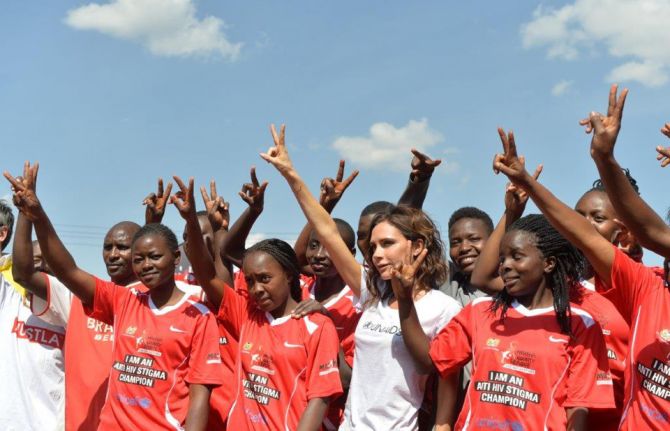
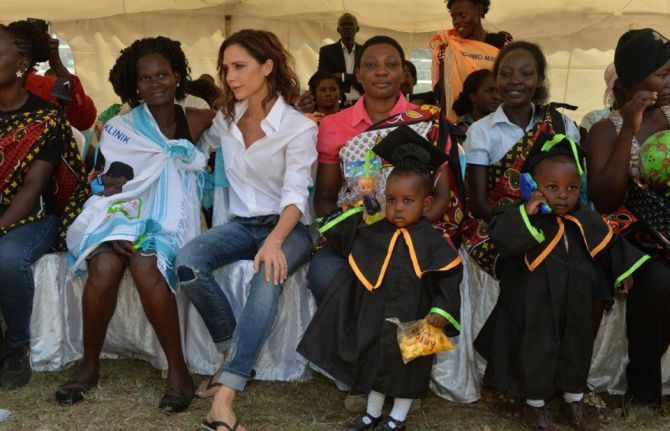
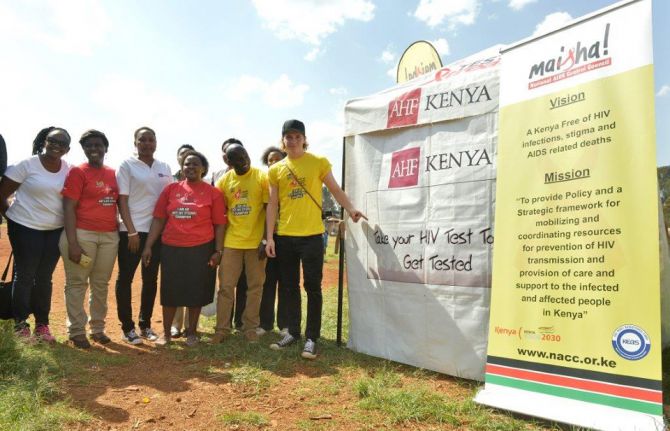
Press Release
Victoria Beckham and son Brooklyn on HIV awareness raising mission to Kenya with Born Free Africa and UNAIDS
09 October 2016 09 October 2016Witnessing first-hand the successes and challenges of Kenya’s AIDS response, Victoria and Brooklyn Beckham call for greater commitment, action and funding to end the AIDS epidemic
Nairobi, Kenya, 8 October 2016—UNAIDS International Goodwill Ambassador Victoria Beckham and her son, Brooklyn Beckham, have completed a three-day mission to Kenya with Born Free Africa and UNAIDS to raise awareness about HIV. Their visit focused on preventing new HIV infections among newborn children and keeping their mothers healthy and the urgency of promoting HIV testing, prevention and treatment for young people, especially adolescent girls and young women.
During the mission, Victoria and Brooklyn Beckham travelled across the country visiting exciting projects that aim to reduce the effects of HIV in Kenya. They met with community and health workers to understand the challenges they face in their work and learned about their many successes. Victoria and Brooklyn spent time with children and talked to young people and adults living with or affected by HIV, hearing first-hand their personal stories and experiences of HIV.
Today, alongside his mother, Brooklyn took part in a national football campaign “Maisha kick out HIV stigma”, which aims to motivate young people to get HIV tested. HIV testing, prevention and treatment services are critical to ending the AIDS epidemic, but often people, in particular young people, do not access services owing to lack of information and the stigma and discrimination linked to HIV. Brooklyn joined the football match and showed off his footballing talents on the pitch.
UNAIDS estimates that 1.5 million people are living with HIV in Kenya, with about 71 000 new HIV infections among adults in 2015. One third of all new HIV infections occurred among young women and adolescent girls aged 15–24 years, who are at particularly high risk. There were 6600 new HIV infections among children in 2015. The Government of Kenya is committed to ending AIDS and in addition to funding its own national HIV work has recently pledged US$ 5 million to the Global Fund to Fight AIDS, Tuberculosis and Malaria and US$ 500 000 to UNAIDS to end AIDS as a public health threat by 2030.
There have been many successes in the AIDS response, but Ms Beckham used the opportunity to highlight that the AIDS epidemic is far from over. “We have come such a long way together to overcome AIDS—we know the facts, we have the tools, but we need commitment, action and funding to see this through! Ending AIDS can happen, but will only happen if we join together and end all forms of stigma and discrimination.”
“Having the support of our International Goodwill Ambassador is extremely important for Kenya in moving towards ending the AIDS epidemic as a public health threat,” said UNAIDS Country Director, Jantine Jacobi.
The mission was organized by the Kenyan Ministry of Health, Born Free Africa and UNAIDS.
Born Free Africa
Born Free Africa is a private philanthropic initiative to eliminate mother to child transmission of HIV. Born Free works with African governments to invest in highly targeted projects to test the hypothesis that catalytic talent can drive significant change within public health systems. Born Free’s investments in Nigeria and Kenya demonstrate that catalytic talent can be a key lever for change. Born Free has also partnered with the fashion community to harness their voice, creativity, and reach to inspire urgency toward the elimination of mother to child transmission of HIV.
UNAIDS
The Joint United Nations Programme on HIV/AIDS (UNAIDS) leads and inspires the world to achieve its shared vision of zero new HIV infections, zero discrimination and zero AIDS-related deaths. UNAIDS unites the efforts of 11 UN organizations—UNHCR, UNICEF, WFP, UNDP, UNFPA, UNODC, UN Women, ILO, UNESCO, WHO and the World Bank—and works closely with global and national partners towards ending the AIDS epidemic by 2030 as part of the Sustainable Development Goals. Learn more at unaids.org and connect with us on Facebook, Twitter, Instagram and YouTube.
Contact
Born Free AfricaTaylor Buonocore
tel. +1 973 723 7105
TBuonocore@healthenvoy.org
UNAIDS
Tina Bille
tel. +41 79 611 0031
billet@unaids.org
Press centre
Download the printable version (PDF)
Region/country

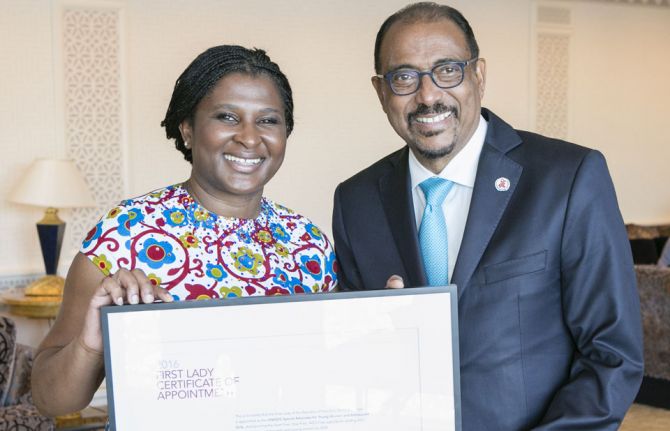
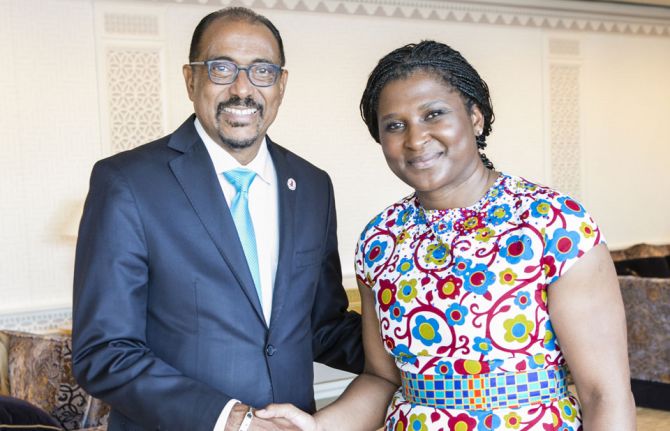

Press Release
UNAIDS Executive Director appoints Monica Geingos, First Lady of Namibia, as a UNAIDS Special Advocate
23 September 2016 23 September 2016NEW YORK/GENEVA, 22 September 2016—The Executive Director of UNAIDS, Michel Sidibé, has appointed the First Lady of Namibia, Monica Geingos, as UNAIDS Special Advocate for Young Women and Adolescent Girls. She will champion the newly launched Start Free, Stay Free, AIDS Free agenda.
Mr Sidibé met with the First Lady on the sidelines of the 71st session of the United Nations General Assembly in New York, United States of America. Madame Geingos will use her position as a UNAIDS Special Advocate to improve the health of adolescent girls and young women.
“I am delighted that Madame Geingos has accepted this position. She will be using her platform to find partners and solutions to some of the difficult health issues facing young women and adolescent girls today, including HIV prevention and sexual and reproductive health, as well as access to education,” said Mr Sidibé. “Young women and adolescent girls around the world have a new champion and we look forward to supporting her work.”
Madame Geingos has spoken out for young women and adolescent girls in Namibia and on the world stage. At the 2016 United Nations High-Level Meeting on Ending AIDS, she was praised for her honest and direct observations on how the world is failing to meet the needs of young women and adolescent girls and on what practical steps are needed to close the critical gaps.
“Young Women and adolescent girls face the conflicting realities of a world that is increasingly recognising gender equality while living in societies that continue to deny them the attainment of this shared right. While I am excited about the encouraging signs to rid the world of its patriarchal cloak, the risks faced by our young women and adolescent girls remain disproportionately and unacceptably high. It is an honour to team up with UNAIDS to work towards a generation that starts free and stays free from AIDS,” said Madame Geingos.
Madame Geingos is a champion of Start Free, Stay Free, AIDS Free, an agenda to put the world on a Super-Fast-Track to end AIDS among children, adolescents and young women by 2020.
START FREE
Eliminate new HIV infections among children (aged 0–14) by reducing the number of children newly infected annually to less than 40 000 by 2018 and 20 000 by 2020. Reach and sustain 95% of pregnant women living with HIV with lifelong HIV treatment by 2018.
STAY FREE
Reduce the number of new HIV infections among adolescents and young women (aged 10–24) to less than 100 000 by 2020. Provide voluntary medical circumcision for HIV prevention to 25 million additional men by 2020, with a focus on young men (aged 10–29).
AIDS FREE
Provide 1.6 million children (aged 0–14) and 1.2 million adolescents (aged 15–19) living with HIV with antiretroviral therapy by 2018. Provide 1.4 million children (aged 0–14) and 1 million adolescents (aged 15–19) with HIV treatment by 2020.
UNAIDS
The Joint United Nations Programme on HIV/AIDS (UNAIDS) leads and inspires the world to achieve its shared vision of zero new HIV infections, zero discrimination and zero AIDS-related deaths. UNAIDS unites the efforts of 11 UN organizations—UNHCR, UNICEF, WFP, UNDP, UNFPA, UNODC, UN Women, ILO, UNESCO, WHO and the World Bank—and works closely with global and national partners towards ending the AIDS epidemic by 2030 as part of the Sustainable Development Goals. Learn more at unaids.org and connect with us on Facebook, Twitter, Instagram and YouTube.


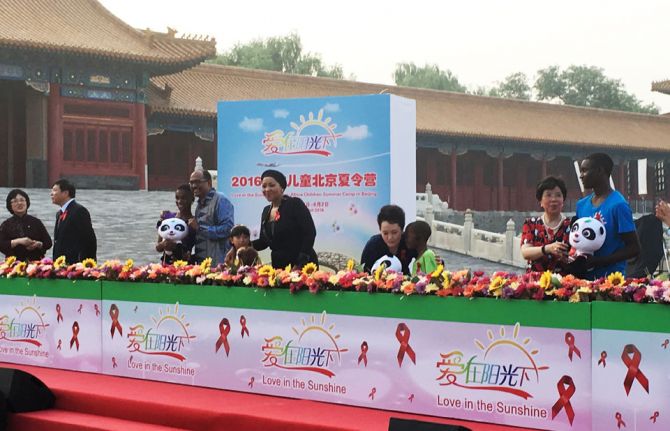
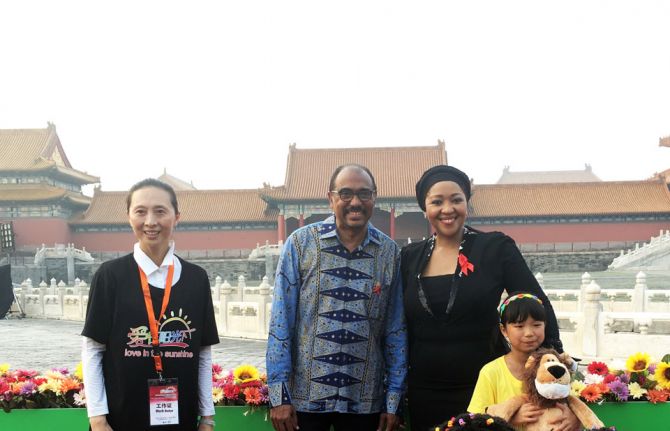
Press Release
UNAIDS participates in China-Africa Children Summer Camp
29 July 2016 29 July 2016Chinese version of award-winning book is launched at the Opening Ceremony.
BEIJING/GENEVA, 29 July 2016—The China-Africa Children Summer Camp opened today under the theme of “Love in the Sunshine”, bringing together 60 young people living with or affected by HIV from China, Ghana, South Africa and Zimbabwe.
Held on the grounds of the Forbidden City, in attendance at the event were the First Lady of China, Peng Liyuan and the First Lady of South Africa, Tobeka Madiba Zuma as well as the Executive Director of UNAIDS, Michel Sidibé and the Director-General of the World Health Organization, Margaret Chan.
As dragonflies, a symbol of change and self-reliance, flew into the open square, the First Lady of China welcomed the participants saying it was a dream to bring together children affected by HIV she has long championed in China with young people from Africa.
“I am very happy that we can be here together,” said Mrs Peng.
This is the first time that young people from outside China have participated in the summer camp happening on the side lines of the Forum on China-Africa Cooperation.
“We want all children to grow to their full potential and realize their dreams, said Mrs Zuma. “This summer camp offers our children a rare opportunity to visit this beautiful country and to share experiences to inspire and strengthen one another.”
Mr Sidibé brought 16-year-old Julia from Ghana with him up to the stage.
“This is an opportunity to say thank you to all of you for your bravery and let you know that we love you and believe in you,” said Mr Sidibé.
At the ceremony and in partnership with the Chinese media organization, Xinhua News Agency, UNAIDS released a Chinese language version of an award-winning book on HIV for children. The Chinese version of The Bravest Boy I Know was given to participants attending the China-Africa Children Summer Camp in Beijing. The book will become an important teaching aid in schools across China to help children understand the issues surrounding HIV and reduce stigma and discrimination faced by children affected by the virus.
The book is the touching story of two friends, Xiao Ming and Xiao Li and their adventures together. Xiao Ming is living with HIV. The story is illustrated by the renowned artist Sujean Rim. It is the heart-warming tale of facing HIV in a positive way. The original version of the book takes place in Africa and has been distributed widely through the Thank You Small Library system in Africa.
“This book is a valuable tool to help parents, teachers and carers explain the complex and emotional issues surrounding HIV to children in their care,” added Mr Sidibé. “Every child deserves to feel protected and loved and to experience a childhood free of stigma and discrimination and every child living with HIV must have access to treatment.”
In 2015, of the 1.8 million children under 15 years of age estimated to be living with HIV worldwide, only half had access to antiretroviral medicines to keep them alive and well. There were 150 000 new HIV infections among children aged 15 and under in 2015.
The Bravest Boy I Know is also available in English, French and Portuguese and is released together with a factsheet on children and HIV and a discussion guide for teachers and carers. In September 2015, the book won first prize in the Popular Medicine category of the British Medical Association.
UNAIDS
The Joint United Nations Programme on HIV/AIDS (UNAIDS) leads and inspires the world to achieve its shared vision of zero new HIV infections, zero discrimination and zero AIDS-related deaths. UNAIDS unites the efforts of 11 UN organizations—UNHCR, UNICEF, WFP, UNDP, UNFPA, UNODC, UN Women, ILO, UNESCO, WHO and the World Bank—and works closely with global and national partners towards ending the AIDS epidemic by 2030 as part of the Sustainable Development Goals. Learn more at unaids.org and connect with us on Facebook, Twitter, Instagram and YouTube.

Press Release
President of Xinhua News Agency receives UNAIDS Leaders and Innovators award
28 July 2016 28 July 2016UNAIDS Executive Director Michel Sidibé has presented the President of Xinhua News Agency, Cai Mingzhao with the UNAIDS Leaders and Innovators Award in recognition of his leadership as a media partner and his contribution to the AIDS response
BEIJING, 28 July 2016—In recognition of the key role that media plays in the Fast-Track response to ending the AIDS epidemic, Cai Mingzhao, the President of Xinhua News Agency, has been presented with the UNAIDS Leaders and Innovators Award at an event held during a joint cooperation visit to Xinhua headquarters in Beijing, China.
The award recognizes Mr Cai’s efforts towards reaching the globally shared vision of Zero new HIV infections, Zero discrimination and Zero AIDS-related deaths.
“Mr Cai is a leader with vision. He understands that the three zeros are not just about the numbers but about social justice and inclusion," said the Executive Director of UNAIDS, Michel Sidibé. “AIDS is not over in any part of the world and Mr Cai’s leadership is helping to ensure that HIV remains at the forefront of public awareness so that no one is left behind.”
With Mr Cai at the helm of Xinhua, the media news group has promoted public awareness of HIV in China and abroad. During the United Nations General Assembly High-Level Meeting on Ending AIDS in June 2016, Xinhua showcased UNAIDS “Fast-Track to an AIDS-Free Generation” message on a giant electronic screen in Times Square, New York. In addition, the group is working with UNAIDS to promote zero discrimination messages through social media and other platforms.
“We understand that the fight against AIDS requires concerted efforts from the whole of society — especially the media.” said Mr Cai. “We have a key role to play to ending AIDS."
UNAIDS recognizes the unique role of the media in the global effort to end the AIDS epidemic. Media is able to reach billions of people with important life-saving messages and to encourage engagement and action. With more than 30 domestic branches and nearly 170 offices overseas, Xinhua is one of the largest news agencies in the world.
The Vice-Minister of Information at the Office of the State Council, Guo Weimin, underlined the importance of Xinhua’s contribution. "Xinhua News Agency is an active supporter of the United Nations Sustainable Development Goals and promotes efforts to involve more people in achieving these aims."
The Vice-Minister of the National Health and Family Planning Committee, Cui Li said, "The cooperation between Xinhua News and UNAIDS is a good example of multi-sector participation and cooperation in advancing the AIDS response."
In March 2016, UNAIDS and Xinhua signed a two-year Memorandum of Understanding of Strategic Cooperation to find innovative solutions to end the AIDS epidemic as a public health threat by 2030 within the framework of the Sustainable Development Goals.
UNAIDS
The Joint United Nations Programme on HIV/AIDS (UNAIDS) leads and inspires the world to achieve its shared vision of zero new HIV infections, zero discrimination and zero AIDS-related deaths. UNAIDS unites the efforts of 11 UN organizations—UNHCR, UNICEF, WFP, UNDP, UNFPA, UNODC, UN Women, ILO, UNESCO, WHO and the World Bank—and works closely with global and national partners towards ending the AIDS epidemic by 2030 as part of the Sustainable Development Goals. Learn more at unaids.org and connect with us on Facebook, Twitter, Instagram and YouTube.

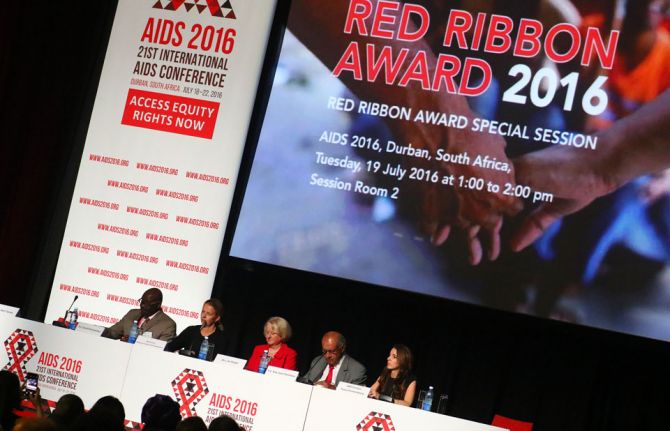

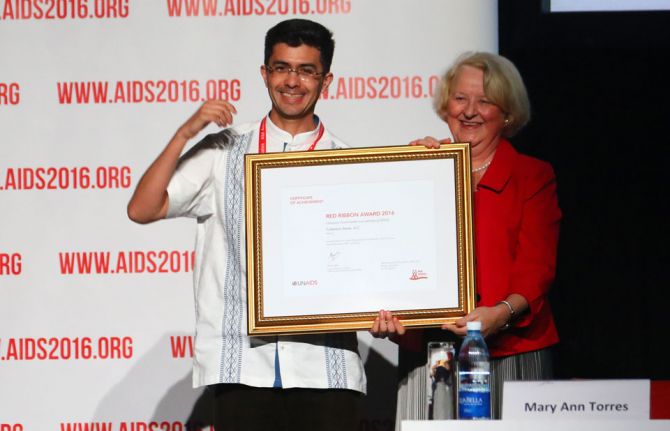
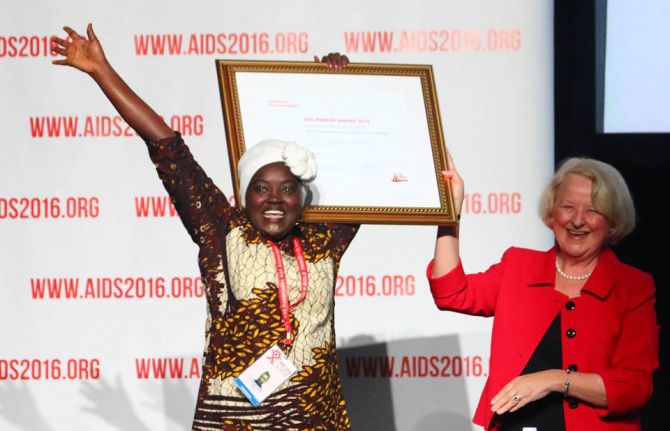
Press Release
Ten organizations receive Red Ribbon Award for outstanding community leadership on AIDS
19 July 2016 19 July 2016DURBAN, 19 July 2016—Ten exceptional community-based organizations have won the 2016 Red Ribbon Award for their inspiring work towards ending or reducing the impact of the AIDS epidemic. They were presented with the prize in a special session at the 21st International AIDS Conference (AIDS 2016) in Durban, South Africa.
“Across regions and cultures, communities are showing the world that ending AIDS is possible. Their courage, innovation and leadership is helping us overcome barriers and better respond to the needs of those most affected by the epidemic.” said UNAIDS Executive Director Michel Sidibe.
The 2016 winning organizations are from Burundi, Mexico, Belize, Kenya, Nigeria, Iran (Islamic Republic of), Nepal, Chile, and New Zealand. Almost 1,000 nominations were received from more than 120 countries, for the Award, which is hosted by UNAIDS in partnership with AIDS 2016, the Global Network of People Living with HIV, the International Community of Women Living with HIV/AIDS, the International Council of AIDS Service Organizations and Irish Aid. A global panel of civil society representatives selected the finalists from a shortlist determined by regional panels.
Each of the winning organizations will receive a US$ 10,000 grant and have been invited to participate in AIDS 2016, where they organize the Community Dialogue Space in the Global Village.
At the Red Ribbon Award special session, the winners were congratulated by Her Royal Highness, Princess Mabel van Oranje of the Netherlands; Her Royal Highness, Princess Tessy of Luxembourg; Minister of Health and Child Welfare of Zimbabwe, David Parirenyatwa; Former President of Fiji H.E. Epeli Nailatikau, and Jan Beagle, Deputy Executive Director, UNAIDS.
“Community-based organizations are taking the lead in shaping the course of the AIDS response. The organizations here today - recipients of the 2016 Red Ribbon Award - are examples to us all of what it truly means to fast track the AIDS response, and to do so in a way which is inclusive, and that advances human rights and gender equality”, Jan Beagle, Deputy Executive Director, UNAIDS
The Red Ribbon Award was first presented in 2006 and since then has been awarded every two years at the International AIDS Conference. This year there were five award categories.
Category one: Good Health & Wellbeing (SDG 3)
Réseau National des Jeunes vivants avec le VIH/SIDA
Colectivo Seres, A.C.
C-Net+
Category two: Reduced Inequalities (SDG 10)
Kenya Sex Worker’s Alliance
Positive Action for Treatment Access (PATA)
Category three: Gender Equality (SDG 5)
Tehran Positive Club
Chitwan Sakriya Women’s Foundation
Category four: Just, Peaceful, & Inclusive Societies (SDG 16)
YouthRISE
Red Nacional de Pueblos Originarios en Respuesta al SIDA
Category five: Global Partnerships (SDG 17)
INA Foundation
About the Sponsors
UNAIDS
The Joint United Nations Programme on HIV/AIDS (UNAIDS) leads and inspires the world to achieve its shared vision of zero new HIV infections, zero discrimination and zero AIDS-related deaths. UNAIDS unites the efforts of 11 UN organizations—UNHCR, UNICEF, WFP, UNDP, UNFPA, UNODC, UN Women, ILO, UNESCO, WHO and the World Bank—and works closely with global and national partners towards ending the AIDS epidemic by 2030 as part of the Sustainable Development Goals. Learn more at unaids.org and connect with us on Facebook, Twitter, Instagram and Youtube.
UN partners
The UN partners involved in the Red Ribbon Award initiative bring together the efforts and resources of all UNAIDS Cosponsors and the UNAIDS Secretariat.
AIDS 2016
The XXI International AIDS Conference (AIDS 2016) is the premier gathering for those working in the field of HIV, as well as policy makers, persons living with HIV and other individuals committed to ending the pandemic. It is a chance for stakeholders to take stock of where the epidemic is, evaluate recent scientific developments and lessons learnt, and collectively chart a course forward. AIDS 2016 will be held in Durban, South Africa from 18 to 22 July 2016. (www.aids2016.org). The International AIDS Society is the convener and custodian of the conference.
Global Network of People Living with HIV
GNP+ is the global network for and by people living with HIV. GNP+ advocates to improve the quality of life of people living with HIV. Driven by the needs of people living with HIV worldwide, GNP+ supports people living with HIV through their organizations and networks. GNP+ works to ensure equitable access to health and social services, by focusing on social justice, rights and more meaningful involvement of people living with HIV in programme and policy development – the GIPA principle. (www.gnpplus.net)
International Community of Women Living with HIV/AIDS
ICW Global emerged to look for answers facing the desperate lack of support, information and services available for women living with HIV. The organization promotes the leadership and involvement of women living with HIV in spaces where policies and programmes are developed and implemented and where the decisions that affect the life of thousands of people who live with the virus are made. The vision is for a just world where women living with HIV are leaders in HIV programmes and policy and realize their universal rights. They dream of a world where women, young women, girls, adolescents living with HIV have full access to care and treatment and enjoy all of their rights: sexual, reproductive, legal, economic and health, regardless of culture, age, religion, sexuality, race or socio-economic status. (www.icwglobal.org)
International Council of AIDS Service Organizations
Founded in 1991, the International Council of AIDS Service Organizations’ (ICASO) mission is to mobilize and support diverse community organizations to build an effective global response to end AIDS. This is done within a vision of a world where people living with and affected by HIV can enjoy life free from stigma, discrimination, and persecution, and have access to prevention, treatment and care. The ICASO network operates globally, regionally and locally, and reaches over 100 countries internationally. (www.icaso.org)
Irish Aid
Irish Aid is the Government of Ireland's programme of assistance to developing countries. Its aid philosophy is rooted in Ireland's foreign policy, in particular its objectives of peace and justice. The international development policy "One World, One Future" reflects Ireland's longstanding commitment to human rights and fairness in international relations and is inseparable from Irish foreign policy as a whole. The Irish Aid programme has as its absolute priority the reduction of poverty, inequality and exclusion in developing countries, with a strong geographic focus on Sub-Saharan Africa. Improving access to quality essential social services such as health, education, services related to HIV and AIDS, and social protection is seen as key to the realisation of human rights, the reduction of poverty, hunger and inequality and the promotion of inclusive economic growth. (http://www.irishaid.gov.ie)
About the Red Ribbon Award
The red ribbon is a global symbol in the movement to address AIDS. The Red Ribbon Award, presented every two years at the International AIDS Conference, is designed to honor and celebrate community based organizations for their outstanding initiatives that show leadership in reducing the spread and impact of AIDS. The award is a joint effort of the UNAIDS family and as such, this year it will place particular emphasis on the organization's newly approved global priority areas of action.
The Red Ribbon Award was first given in 2006 and has recognized 85 organizations from over 50 different countries since then as leading community-based responses to AIDS. Such organizations lie at the heart of the response to the AIDS epidemic – displaying extraordinary courage, resilience and strength in addressing one of the greatest challenges of our time. Using creative and sustainable ways to promote prevention of sexual transmission, and prevention among people who use drugs, provide treatment, care, and support to people living with HIV and demonstrating innovation in the face of stigma and discrimination through advocacy and human rights, and stopping new HIV infections in children and keeping mothers alive, and taking care of women’s health, these examples of community leadership are showing us in practical terms how to reverse a global epidemic – one community at a time.
Press centre
Download the printable version (PDF)

Press Release
Kaiser/UNAIDS Study Finds Donor Government Funding for HIV Fell in 2015 for First Time in 5 Years
15 July 2016 15 July 2016Funding declined from a majority of donor governments assessed, including the U.S.
Donor government funding to support HIV efforts in low- and middle-income countries fell for the first time in five years in 2015, decreasing from US$8.6 billion in 2014 to US$7.5 billion, finds a new report from the Kaiser Family Foundation and the Joint United Nations Programme on HIV/AIDS (UNAIDS) released in advance of the 2016 International AIDS Conference.
Funding for HIV declined for 13 of 14 donor governments assessed in the analysis, in part due to the significant appreciation of the U.S. dollar that resulted in the depreciation of most other donor currencies. Yet even after accounting for this, funding declined for the majority of governments assessed.
Total funding from the U.S. government fell from US$5.6 billion to US$5 billion, but this was mostly due to a timing issue as the U.S. shifted bilateral funds to 2016 while it implements new and expands existing programs. Without counting the US$411 million reduction in bilateral U.S. funding, most of which is expected to be provided in 2016, total funding declined overall by 8 percent.
“The decline in international funding for the HIV response is worrying,” said Luiz Loures, UNAIDS Deputy Executive Director. “Countries still need urgent support over the next few years to Fast-Track their responses to HIV, enabling them to end the AIDS epidemic by 2030 and save millions of lives. Diverting resources from the HIV response now will mean much greater human and financial costs over the long-term.”
The U.S. continued to provide the lion’s share of total funding (bilateral and multilateral) provided by donor governments (66.4%), followed by the U.K. (13%). France provided 3.7 percent of funding, Germany provided 2.7 percent, and the Netherlands provided 2.3 percent.
“2015 marked a drop in donor funding for HIV,” said Kaiser Family Foundation Vice President Jen Kates, Director of Global Health and HIV Policy. “Donors faced many competing funding demands, including humanitarian emergencies and the refugee crisis, all against a backdrop of fiscal austerity in a number of countries. Looking ahead, donor funding for HIV remains uncertain as leading donors face changes in political leadership and the world is still digesting the effects of Brexit.”
The new report, produced as a partnership between the Kaiser Family Foundation and UNAIDS, provides the latest data available on donor funding disbursements based on data provided by governments. It includes their bilateral assistance to low- and middle-income countries and contributions to the Global Fund as well as UNITAID.
UNAIDS
The Joint United Nations Programme on HIV/AIDS (UNAIDS) leads and inspires the world to achieve its shared vision of zero new HIV infections, zero discrimination and zero AIDS-related deaths. UNAIDS unites the efforts of 11 UN organizations—UNHCR, UNICEF, WFP, UNDP, UNFPA, UNODC, UN Women, ILO, UNESCO, WHO and the World Bank—and works closely with global and national partners towards ending the AIDS epidemic by 2030 as part of the Sustainable Development Goals. Learn more at unaids.org and connect with us on Facebook, Twitter,Instagram and Youtube.
The Kaiser Family Foundation
Filling the need for trusted information on national health issues, the Kaiser Family Foundation is a non-profit organization based in Menlo Park, California.
Contact
UNAIDS GenevaMichael Hollingdale
tel. +41 22 791 5534
hollingdalem@unaids.org
Kaiser Family Foundation
Katie Smith
tel. +1 202 654-1439
ksmith@kff.org
Press centre
Download the printable version (PDF)


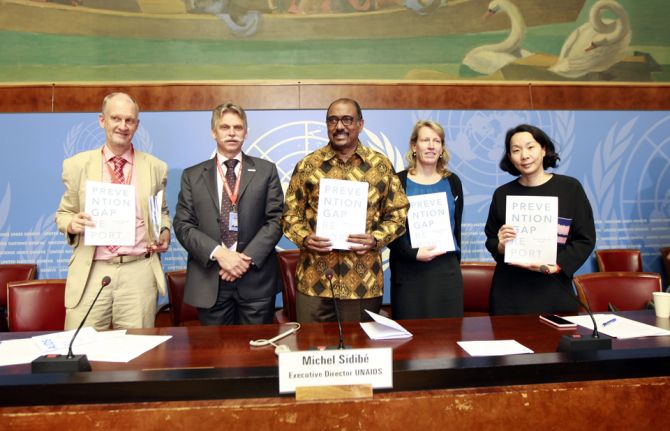

Press Release
UNAIDS warns that after significant reductions, declines in new HIV infections among adults have stalled and are rising in some regions
11 July 2016 11 July 2016Globally, new HIV infections among adults and children were reduced by 40% since the peak in 1997. However, new analysis from UNAIDS shows that new HIV infections among adults have stalled, failing to decline for at least five years. The report outlines what is needed to step up prevention efforts
GENEVA, 12 July 2016—A new report by UNAIDS reveals concerning trends in new HIV infections among adults. The Prevention gap report shows that while significant progress is being made in stopping new HIV infections among children (new HIV infections have declined by more than 70% among children since 2001 and are continuing to decline), the decline in new HIV infections among adults has stalled. The report shows that HIV prevention urgently needs to be scaled up among this age group.
HIV prevention gap among adults
The Prevention gap report shows that an estimated 1.9 million adults have become infected with HIV every year for at least the past five years and that new HIV infections among adults are rising in some regions. The Prevention gap report gives the clear message that HIV prevention efforts need to be increased in order to stay on the Fast-Track to ending AIDS by 2030.
- Eastern Europe and central Asia saw a 57% increase in annual new HIV infections between 2010 and 2015.
- After years of steady decline, the Caribbean saw an 9% rise in annual new HIV infections among adults between 2010 and 2015.
- In the Middle East and North Africa, annual new HIV infections increased by 4% between 2010 and 2015.
- There have been no significant declines in any other regions of the world.
- In Latin America the annual number of new adult HIV infections increased by 2% since 2010; New HIV infections declined marginally in western and central Europe and North America and in western and central Africa since 2010; New HIV infections among adults declined by 4% in eastern and southern Africa since 2010, and by 3% in Asia and the Pacific since 2010.
“We are sounding the alarm,” said Michel Sidibé, Executive Director of UNAIDS. “The power of prevention is not being realized. If there is a resurgence in new HIV infections now, the epidemic will become impossible to control. The world needs to take urgent and immediate action to close the prevention gap.”
The AIDS epidemic has had a huge impact over the past 35 years. Since the start of the epidemic, 35 million people have died from AIDS-related illnesses and an estimated 78 million people have become infected with HIV.
Equity and access for key populations
In 2014, key populations, including gay men and other men who have sex with men, sex workers and their clients, transgender people, people who inject drugs and prisoners, accounted for 35% of new HIV infections globally. It is estimated that men who have sex with men are 24 times more likely to become infected with HIV than the general population, while sex workers are 10 times more likely and people who inject drugs are 24 times more likely to become infected than the general population. In addition, transgender people are 49 times more likely to be living with HIV and prisoners are five times more likely to be living with HIV than adults in the general population
It is essential for key populations to have access to the full range of HIV prevention options in order to protect themselves and their sexual partners from HIV. “Today, we have multiple prevention options,” said Mr Sidibé. “The issue is access—if people do not feel safe or have the means to access combination HIV prevention services we will not end this epidemic.”
Prevention dividend from HIV treatment still to be realized
The report highlights that the major hopes for antiretroviral therapy to have an impact on preventing new HIV infections are starting to be realized, although the full benefits may not be seen for some years.
The Prevention gap report estimates that over half of all people living with HIV, 57%, now know their HIV status, that 46% of all people living with HIV have access to antiretroviral treatment and that 38% of all people living with HIV have viral suppression, keeping them healthy and preventing onward transmission of the virus. This underscores the urgent need for the UNAIDS 90–90–90 targets to be met to realize the full potential of antiretroviral therapy. The 90–90–90 targets are 90% of people knowing their HIV status, 90% of people who know their status accessing antiretroviral treatment and 90% of people on treatment having suppressed viral loads.
HIV prevention funding gap
The reports of rising numbers of new HIV infections are coming as data reveal donor funding has declined to its lowest levels since 2010. International donor contributions dropped from a peak of US$ 9.7 billion in 2013 to US$ 8.1 billion in 2015. Low- and middle-income countries are stepping up to fill the gap, with domestic resources accounting for 57% of the US$ 19.2 billion total funding in 2015.
The report notes that although international funding, the main source of funding for HIV prevention for people at higher risk of HIV, has reduced, some major donors are making bold commitments to ensure that funding reaches the people most affected by HIV. In June 2016, the United States of America announced the launch of a new US$ 100 million Key Populations Investment Fund to increase access to HIV services for key populations.
The current allocation of resources for HIV prevention is falling far short of what is needed. Currently, 20% of global resources for HIV are being spent on HIV prevention. The report indicates that to have maximum impact funding should focus on the location and population approach in order to reach people at higher risk with combination prevention options where they live and work.
Regional HIV prevention gaps
The report details the trajectory of new HIV infections and looks at which populations and which locations are most affected. It also outlines where countries need to make more tailored HIV prevention investments.
In eastern and southern Africa, for example, three quarters of all new HIV infections among adolescents aged 10–19 years are among adolescent girls. Adolescent girls are often prevented from accessing HIV services owing to gender inequality, a lack of age-appropriate HIV services, stigma, a lack of decision-making power and gender-based violence. In 2014, only 57% of countries globally (of 104 countries reporting) had an HIV strategy that included a specific budget for women. It is estimated that worldwide only three in 10 adolescent girls and young women between the ages of 15 and 24 years have comprehensive and correct knowledge about HIV. Reaching adolescent girls and young women, especially in sub-Saharan Africa, will be a key factor in ending the AIDS epidemic.
In eastern Europe and central Asia, 51% of new HIV infections occur among people who inject drugs. More than 80% of the region’s new HIV infections in 2015 were in the Russian Federation. The epidemic is concentrated predominantly among key populations and their sexual partners, in particular people who inject drugs, who accounted for more than half of new HIV infections in 2015. However there is very low coverage of prevention programmes, in particular harm-reduction interventions among people who inject drugs.
In the Middle East and North Africa, 96% of new HIV infections occur among key populations, predominantly among people who inject drugs, men who have sex with men and female sex workers and their sexual partners. However, prevention programmes for men who have sex with men and sex workers rarely receive support from domestic resources or through public services.
In western and central Europe and North America, around half of all new HIV infections occur among gay men and other men who have sex with men and while a significant proportion of resources are being invested for this key population group, prevention efforts are failing to have an impact. Between 2010 and 2014, new HIV diagnoses among men who have sex with men increased by 17% in western and central Europe, and by 8% in North America.
The report shows the complexity of the AIDS epidemic and how the populations and locations most affected change dramatically across each country and region. It also shows that investments need to be made in effective HIV programmes that are proven to make a significant difference in reducing the number of new HIV infections.
Combination HIV prevention, gaps and opportunities
Compared to 20 years ago when HIV prevention options were limited, there is now a range of options available to suit people’s needs throughout their lives to ensure that they can protect themselves from HIV.
UNAIDS urges countries to take a location and population approach to HIV programming efforts following five prevention pillars, to be delivered comprehensively and in combination:
- Programmes for young women and adolescent girls and their male partners in high-prevalence locations.
- Key population services in all countries.
- Strengthened national condom programmes.
- Voluntary medical male circumcision in priority countries.
- PrEP for population groups at higher risk of HIV infection.
Closing the HIV prevention gap
“Science, innovation and research have provided new and effective HIV prevention options, rapid diagnostics and improved treatment for HIV,” said Mr Sidibé. “Investing in innovation is the only way to secure the next big breakthrough—a cure or a vaccine.”
The data in the report, collected from more than 160 countries, demonstrate that enormous gains can be achieved when concerted efforts are made. It outlines that by 2015 some 17 million people had access to antiretroviral therapy, double the number in 2010 and 22 times the number in 2000.
UNAIDS will be calling on implementers, innovators, communities, scientists, donors and others at the 2016 International AIDS Conference, taking place from 18 to 22 July, in Durban, South Africa, to close the prevention gap.
|
Global summary of the AIDS epidemic in 2015 |
||
|
Number of people living with HIV |
Total |
36.7 million [34.0 million–39.8 million] |
|
Adults |
34.9 million [32.4 million–37.9 million] |
|
|
Women |
17.8 million [16.4 million–19.4 million] |
|
|
Children (<15 years) |
1.8 million [1.5 million–2.0 million] |
|
|
Number of people newly infected with HIV |
Total |
2.1 million [1.8 million–2.4 million] |
|
Adults |
1.9 million [1.7 million–2.2 million] |
|
|
Children (<15 years) |
150 000 [110 000–190 000] |
|
|
AIDS-related deaths |
Total |
1.1 million [940 000–1.3 million] |
|
Adults |
1.0 million [840 000–1.2 million] |
|
|
Children (<15 years) |
110 000 [84 000–130 000] |
|
|
Number of people on HIV treatment |
Total |
17 million |
UNAIDS
The Joint United Nations Programme on HIV/AIDS (UNAIDS) leads and inspires the world to achieve its shared vision of zero new HIV infections, zero discrimination and zero AIDS-related deaths. UNAIDS unites the efforts of 11 UN organizations—UNHCR, UNICEF, WFP, UNDP, UNFPA, UNODC, UN Women, ILO, UNESCO, WHO and the World Bank—and works closely with global and national partners towards ending the AIDS epidemic by 2030 as part of the Sustainable Development Goals. Learn more at unaids.org and connect with us on Facebook, Twitter, Instagram and YouTube.
Press centre
Download the printable version (PDF)

